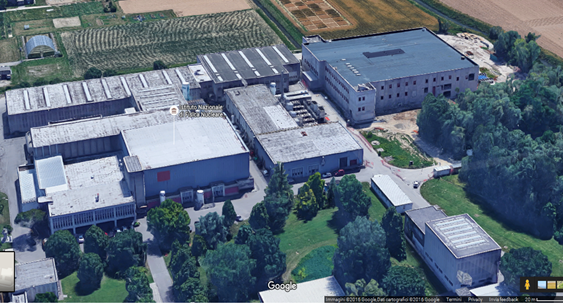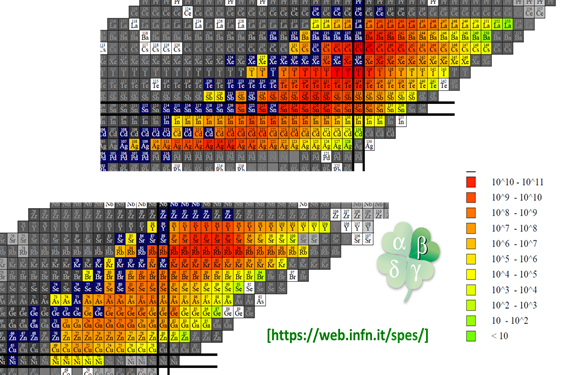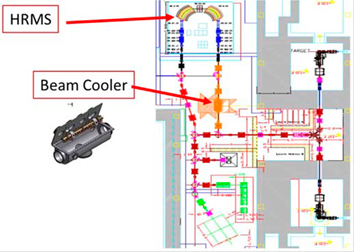INTRODUCTION
The Legnaro National Laboratory [1] is located in the North West part of Italy, in the Veneto region in between two splendid towns: Padua, the place where Galileo Galilei was giving his lessons and Venice, the door towards the Eastern World. The Laboratory was born in the 60’s as a Research Laboratory of the Padua University and only in the 70’s it became the first National Laboratory of the National Institute for Nuclear Physics (INFN). In the Laboratory, different accelerators are running: in particular, the main activity related to Nuclear Physics is performed at the TANDEM-ALPI complex, which is composed by a 16MV Tandem XTU Van De Graaff accelerator, which can work either standalone or as injector of the ALPI Linac Accelerator. The LINAC can work even alone, with the Super Conductive PIAVE RFQ injector opportunely designed for high intensity beams.
Close to these facilities the new SPES [2] facility is under construction.
Besides the main accelerator complex, two smaller Van de Graaff machines are also running: a 2MV accelerator, which can mainly accelerate p and He beams and the 7MV CN accelerator. These machines are mainly used for interdisciplinary physics (material, environmental, radiobiology, micro-dosimetry,cultural heritage), but also for nuclear physics and astrophysics purposes. At the CN, in particular, a pulsed neutron beam for experimentation can be delivered.
In Figure 1 a view of the new facility complex is shown, where on the left the new SPES building is shown. This building is hosting in the centera proton driver, which consists of a commercial cyclotron, unique in its kind, custom built in order to reach up to 750

Figure 1 View of the new SPES building (on the upper right) and of the old TANDEM _ALPI complex (on the left).
In particular the SPES -
On the left part, towards the area of the old buildings, where the Tandem and the LINAC accelerators are installed, the two bunkers dedicated to the production of radioactive beams have been built, fitted with high technological plants for safety and radioprotection reasons (Figure 2).
MATERIALS AND METHODS
The main part of the SPES facility, which is of interest of the Nuclear Physics Community, is the SPES-
The B70 cyclotron, built by the BEST company can deliver two beams at the same time, at present with the same energy, but different intensities up to a maximum of 750
The RIBs project consists of a proton beam of 200
Since the Front End is working under a high radiation field inside the bunker, a strong study on radiation hard material has been performed in collaboration with the Pavia University and INFN section: a new version of the FEhas been designed, where all parts have been renewed for what it concerns the materials and sealing to fulfill the radiation hardness requests.
Different kind of TIS have been developed within the SPES project: a Surface Ion Source (good efficiency and selectivity for elements like Rb, cs, Ba); a Plasma Ion Source (necessary to ionize elements with high ionization potential, but with very poor selectivity); a Laser Ion Source (which is based on the laser resonant photo-ionization and it is very powerful and highly selective).
The isotopes produced in the target andionized by the source are extracted and directed towards the first selective element, that is a Wien Filter able to select isotopes up to
In Figure 4 the layout of the transport line from the production bunker to the low Energy area (non-reaccelerated RIBs) is shown: after the Wien Filter, which is still installed in the production bunker the beam is selected and sent to a 90° Magnetic Dipole and then transported through a series of electrostatic elements (Triplets, Dipoles) until a DiagnosticTape Station, designed to characterize the beam production.
On the other hand, the RIBs can be also transported towards a Beam Cooler necessary to couple the emittance of the beam to the High Resolution Mass Spectrometer (HRMS), which is under design so to reach a separation of
At the exit of the HRMS the transport line can either be sent back to the low Energy Area or to go towards the post-accelerator: before reaching the ALPI accelerator the beam is sent to a Charge Breeding Stage, necessary to charge up the isotopic species from 1+ to n+, after which a further Medium Resolution Mass Spectrometer is used to clean up from possible contaminants generated in the Charge Breeder.In Figure 5 a picture of the Charge Breeder, which is under installation at LNL is shown together with some optical elements of the 1+transport line, called ADIGE.
Moreover, a new normal conductive Resonant Frequency Quadrupole (RFQ), entirely designed at LNL is under production. It will properly inject the RIBs into the Linac ALPI for post-acceleration: the RFQ injection energy is 5.7 keV/n and the exit energy 727 keV/n.
The ALPI post-accelerator is undergoing a major upgrading in terms of transmission properties, beam intensities and energies. Some further cryostats will be installed in the forthcoming months so to give the possibility of reaching 10-11 MeV/n for A=130-140.
Instrumentation and Scientific program
The SPES performances in terms of beam intensities at the production/extraction point (after the 1+ ionization) and at the secondary target (experiment) position (post-accelerated intensities) have been evaluated with MCNPX. A picture of the calculated intensities as reported on the LNL website [7] is shown for re-accelerated beams. Users can download the Beam Tables together with the description of the system from the web page. Moreover, specific tests on the TIS SPES system have demonstrated the capability of the sliced target to produce extra yields with respect to the bulk configuration, which was originally used at HRIBF at Oak Ridge National Laboratory (USA) [8] (Figure 6).

Figure 6 Calculated re-accelerated intensities for SPES: published on the Web site: https://web.infn.it/spes/index.php/news/spes-beam-tables
The SPES scientific program has been discussed in several International meetings, where several Letters of Intent have been presented. Several up to date instrumental set-ups (PRISMA [9], GARFIELD [10], GALILEO [11] etc.) are present at LNL and have been updated to be used with RIBS. Some other will be travelling apparatuses (like AGATA [12], FAZIA [13] and NEDA [14]) and will come to LNL for particular experimental campaigns. Some moreinstruments are under development on purpose for the experimental activity at SPES (ATS - active target for SPES,
CONCLUSIONS AND OUTLOOK
The SPES facility is going in the installation phase in the forthcoming years. The proton driver that is the B70 cyclotron from BEST is installed and the training of the INFN personnel is undergoing. During the next two years the 1+ transport line, the Charge Breeder, the MMRS and the FE will be installed. According to the SPES schedule the first non re-accelerated radioactive beams will be delivered to the Users in 2020, in the low energy area. In the meanwhile, the RFQ will be installed and commissioned, so that the post-acceleration part of the facility will be tested with stable and pilot beams.
Re-accelerated RIBs are foreseen in 2021, with a high resolution mass selection in 2022.
Users are welcome from all over the world, so that SPES can be considered an International facility User Oriented.


















